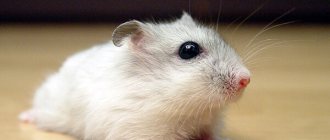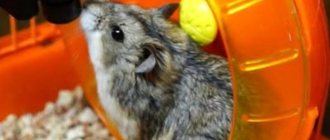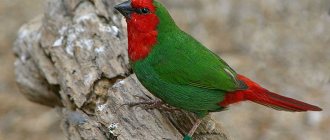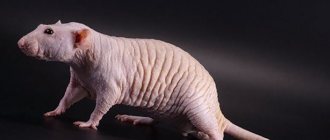The Roborovsky hamster (Phodopus roborovksi) is one of the smallest representatives of the hamster family, belonging to the genus of hairy hamsters. It is no larger than a small chicken egg.
The dwarf rodent received its name in 1903 thanks to its discoverer, V.I. Roborovsky, famous for his participation in three expeditions to Tibet together with N.M. Przhevalsky. The hamster was discovered by a zoologist in the Tien Shan mountains in 1894. In addition to China, the species lives in the wild in the deserts of Mongolia. In the 70s of the 20th century, the animal was brought to the USSR and successfully preserved by the Moscow Zoo. In America and European countries, the Roborovsky hamster has not taken root. Holland has achieved great success in breeding.
Roborovsky's hamster
Roborovsky hamsters are very small compared to other hamsters. They are named in honor of the traveler scientist V.I. Roborovsky, who first discovered them in Tibet at the beginning of the last century. However, for the first time in the discoverer’s homeland they appeared only in the second half of the 20th century. It is noteworthy that the species practically did not manage to take root in European countries.
Differences between the Roborov hamster and the Djungarian hamster:
| Roborovskys | Dzungarian |
| The smallest representative, 4-5 cm long. | They reach a size of up to 10 cm. |
| Difficulties arise with reproduction. | They reproduce well. |
| Pugnacious with neighbors in a cage. | No problems with other hamsters. |
| At home they can live up to 4 years. | On average they live about 2 years. |
| Uniform fur color, except for the white belly and eyebrows. | There is a dark stripe on the back, and a diamond-shaped stripe on the head. |
| Due to the difficult conclusion, they are very rare. | One of the most common types of hamsters. |
| The most expensive in terms of price. | The cost is several times less for Roborov hamsters. |
| They usually do not bite, only in rare cases. | They also rarely bite, but it hurts more than the Roborovsky ones. |
| They have a snub-nosed muzzle. | The Dzungarian species has a sharp muzzle. |
| Hard to tame. They are afraid of sudden movements and loud sounds. They may faint. | They are not afraid of people and quickly get used to them. |
| This species is not suitable as a pet for children. | Ideal pets for children. |
| Due to their small size, they can squeeze through holes in the cage. Must be kept in special containers made of glass and plastic. But due to their size, they do not require huge cages to contain them. | Contained in ordinary cages. |
| They are clean and have no unpleasant odor. | There is an unpleasant odor if not properly cared for. |
| They practically don’t get sick. | Sometimes they get sick, but not often. |
Natural habitat
The hamster is distributed almost everywhere on the Eurasian continent: it can be found in European countries and in some regions of Russia. Mainly prefers to settle in steppes, forest-steppes, meadows, and floodplains. It does not go high into the mountains - the maximum height above sea level where the animal can be found is 1.5 km.
Under some circumstances, it can settle even next to a person: in gardens and vegetable gardens. Particularly large numbers of rodents live in areas of active farming. They say that the animals were even found on the territory of new buildings, which were once fields or vegetable gardens, where the animals adapted to existence.
What does a hamster look like?
The smallest hamsters are sand-colored, with no additional stripes or markings on their fur. At the very roots, the color of the fur is darker than grayish. This color is considered natural, which occurs in nature. In addition to their natural color, there are hamsters with cream-colored fur.
The color is not uniform; on the belly and near the antennae it is very light, almost white. Sometimes you can see a rare color in the form of white fur on the entire face. The ears are gray.
Girl or boy?
It can be difficult to correctly sex a young or very small Roborovsky, especially when they are not tame. It's always a good idea to consult diagrams, have them looked at by a veterinarian, or learn how to properly handle them in the field so you don't harm them.
Female Roborovian hamsters: smell less, are dominant, may be slightly larger, do not have a yellow odor on their bellies.
Male Roborovsky: has a stronger odor, very similar to male/chlorinated mice, with a yellow spot on the belly that represents the odor, very active, submissive and may be slightly smaller than the female.
There is a slight difference between the temperament of men and women, so it is entirely your choice if you want a certain gender or not.
You can keep 2-3 males together or 2-3 females together without problems as long as they are presented young. If you keep a male and female together, they will breed, fight, and the female will dominate, attack, and even kill the male in some more extreme cases. Female hamsters are very dominant. It's best to stick to same-sex couples, but they can live happily alone.
Behavior
Roborov hamsters are very pugnacious. Same-sex individuals can still somehow get along and live in peace. Animals of different sexes, even though they give birth to offspring, will fight constantly. They are very active both at night and during the day, it is interesting to watch them, the main thing is not to scare them.
It is not recommended to add a new pet to hamsters that have lived together for a long time. They will begin to offend the newcomer, will not accept him and are unlikely to become friends in the future.
Roborovian hamsters are very shy, which makes them almost impossible to tame. Any loud noise can frighten them greatly. You should not laugh or shout loudly near them.
Breed Features
The animal can boast (although, do people boast in such cases?) not only with a very small tail. This is not their only feature. They are very peaceful and practically do not bite. Even if you miraculously provoke his wrath, he will not harm you. Their teeth are completely incapable of biting through human skin. Their eyebrows also stand out. Well, like eyebrows... eyebrows. They are also tiny. They are usually lighter in color and are clearly visible on the face.
Ladies and gentlemen, attention to the screen! Here they are, those same famous Roborovsky eyebrows!
In addition, hamsters are very timid. They are very difficult to tame. Perhaps that is why they are so poorly distributed and known.
IMPORTANT: the bars of a regular cage will not hold them. Most of them will pass through it as if through a door. We will tell you below how to properly arrange housing for such a baby.
Roborovsky hamster cage
Due to the fact that Roborovian hamsters are small, it is not recommended to keep them in a cage with large holes. They will escape through the bars of standard cages. To keep them, you need cages with closely spaced bars or special glass or plastic cages.
The cage should have an area of 80 by 60 cm. The pet must have a running wheel with a diameter of about 20 cm. Since the animals are very active, they must spend their energy somewhere, otherwise they will quarrel with all their neighbors if they do not live alone. Roborovsky hamsters love to hide, so it is necessary to provide them with different types of shelter in the cage in the form of houses, holes and tunnels.
You need to pour sand or sawdust in a layer of about 3 cm on the floor of the cage. If you have baby hamsters, you definitely need to make a separate shelter for them. Small branches, grass, hay or moss are suitable for this. The main thing is to create comfortable conditions. Place a container for food on the floor, a separate container for water and a mineral stone. Place a tray in the corner of the cage. Hamsters can be trained to go to the toilet if desired, but this must be done while they are still babies.
Robo Lifespan
Roborovian hamsters tend to live slightly longer than other species of hamsters. Their average lifespan is 3-4 years and has been known to live longer than this in some cases. They are less susceptible to many of the other diseases that Syrian, Chinese and Russian dwarf hamsters acquire, which can be a great benefit to many pet owners. There are other diseases that have a much higher risk than other hamsters such as; broken bones, crush injuries, ticks or pincers, allergies, overgrown nails and teeth, rapid weight loss, seasonal itching, skin conditions, eye loss (bulging eyes, whole eyes popping out, or breakouts) due to shallow seating of their eyeballs.
What to feed a Roborovsky hamster
Roborov hamsters are not picky eaters. Their diet is practically no different from that of other breeds. Pets are fed special prepared food consisting of grain crops, various types of seeds, and corn. In addition, they love to feast on vegetables and fruits.
It is necessary to try to diversify the diet of hamsters. It's good for their health. In addition to fruits and vegetables, it is necessary to give more greens, they love them very much. Some owners advise feeding their pets bread soaked in milk.
Foods that hamsters are recommended to eat:
- millet;
- grain feed;
- vegetables and fruits;
- wheat (must be sprouted);
- fresh chicken (necessarily without salt);
- fish (not salted);
- white bread, pre-soaked in milk;
- porridge from buckwheat, rice, millet and oatmeal;
- light low-fat cottage cheese;
- low-fat sour cream;
- eggs (it is recommended to give quail and chicken);
- not hot or spicy greens (lettuce, dandelion).
Foods that should never be fed to hamsters:
- products containing cocoa powder;
- salty and sweet foods;
- seasonings, herbs and spices;
- any canned food and pickled vegetables;
- Fruit seeds and seeds are strictly contraindicated;
- semi-finished products;
- pine nuts and almonds;
- cabbage and tomatoes;
- semi-finished products;
- sour (citrus) and astringent (persimmon) fruits;
- food from a person's table;
- garlic and onion;
- dirty, stale, cold and hot food.
Particular attention is paid to the diet of pregnant and lactating hamster mothers. At this time, her body is in great need of protein, so she is fed fresh white chicken meat, fish without salt and mealworms.
Babies, like mothers, also need protein while growing. Therefore, they are fed chicken or quail eggs, fish, mealworms, cottage cheese and porridge.
Hamsters recover quickly, so it is necessary to monitor how much fat, protein and carbohydrates they consume. You need to make sure your pet moves more often. A running wheel and dietary restrictions will help him get back to normal.
How to care
Roborov hamsters are very freedom-loving and capricious. Therefore, their survivability in the wild is very high. It is at home that hamsters more often prevail in stressful conditions. They get scared by strong sounds and even faint. It is worth taking care of their health and not making noise near their cage. They avoid human hands and do not like to be touched or petted.
It is not recommended to take them out of their cages. If the hamster managed to escape from the cage or from the hands of the owner, it is worth catching it with the help of harmless traps, luring it with its favorite food.
Due to their small stature, the animals practically do not climb the walls of the cages, so keeping them in glass and plastic cages will not be stressful for them. In this case, it is very important to create well-ventilated conditions. It is better to purchase plastic containers for keeping hamsters. In glass containers, the walls fog up and an unfavorable atmosphere is created for the life of pets, but favorable for the growth of microbes and bacteria.
You cannot smoke near your pet’s cage or place its cage in drafts. It is necessary to protect hamsters from living near areas of mold and dampness.
You need to clean the cage several times 2-3 times a week, change the sand and sawdust when they become dirty. Every day, be sure to clean the feeder and change the water to clean water.
For the toilet, you need to purchase a special tray and filler for it. It also needs to be cleaned so as not to spread germs and the pet does not get sick.
Nutrition
How long hamsters live depends on what they eat. Their diet should consist of store-bought food. Do not skimp when choosing a feed mixture; often a cheap mixture contains poorly processed, dusty grains and seeds.
The following products are also allowed:
- Fruits and berries: pears, apples, apricots, raspberries, currants, dried fruits. This is given as a treat and not often, once or twice a week is enough.
- Vegetables: carrots, pumpkin, zucchini.
- Greenery. Both homemade (parsley, dill) and forest (dandelion, nettle) are suitable.
- Seeds and nuts.
- Protein food. Chicken, fish, cottage cheese.
- "Live" meat. You can buy grasshoppers and worms at the pet store.
List of prohibited products:
- Sausages.
- Bakery products.
- Watermelons and melons.
- Citrus.
You need to feed the animal twice a day, or four times, but in small portions. Products should always be fresh. Check your hamster's supplies regularly and throw away anything that spoils. Poisoning from spoiled food can be fatal.
Reproduction
Hamsters are known for their fertility, but this does not apply to the Roborov breed. A litter of this breed can produce a maximum of 5 babies, but usually the number is much less.
Before breeding a pair, it is imperative to introduce the hamsters and let them become friends, or better yet, form a pair from a very early age. A lattice partition is placed in the cage with pets and the hamsters are protected from each other. This will give you the opportunity to get used to each other and not fight.
To properly breed Roborov hamsters you need to know the following:
- You need to form a pair at 4 months of age;
- females become pregnant on the day of mating, pregnancy lasts about 23 days;
- a pregnant female should not be touched or disturbed; it is better to isolate her from other relatives;
- labor can last up to 2 hours;
- babies are born deaf, blind and without hair, weighing 1 gram and height 1 cm;
- a woman in labor after childbirth is very angry and pugnacious;
- In no case should you touch newborns with your hands unless you can do without it; it is better to use a foreign object for this;
- after 25 days you can separate mother and babies.
Babies may need complementary feeding. It is necessary to feed them protein foods during growth. Usually they are given fish, eggs, cottage cheese.
Breeding at home
Pairs need to be formed in infancy. If this was not possible, then the adults should be given time to get used to each other. At the pet store you can purchase a special grid for the cage, which will allow the animals to sniff, but not make contact, this will eliminate conflicts. The grate is removed after eight to ten days.
The duration of pregnancy is 25 days. At this time, you should not disturb the pregnant woman, she may show aggression and bite
Pay special attention to nutrition; your diet should be as varied as possible. Set up her home properly
Give the opportunity for privacy; for this purpose, install an individual house, or better yet two. Pour some sawdust, and with their help the expectant mother will make a nest for her offspring.
Female Roborovskis are not as fertile as females of other species. The litter does not exceed six cubs. Hamsters are born hairless and blind. After a week of life, their bodies become covered with fluff. They become independent within two weeks. Baby purees and cereals are suitable as complementary foods. It is better to hold off on fruits and herbs so as not to cause loose stools in babies.
How to tame
To tame a Roborov hamster, you need to take the following steps:
- The hamster must get used to its owner and trust him. To do this, the owner needs to give him food himself. Quiet, calm conversations will allow the animal to get used to the owner's voice.
- Offer hand-held treats daily. When the animal begins to approach without fear, place the treat in your palm.
- When the hamster gets used to treats served in this way and begins to eat them while sitting on your hand, you can slightly lift it and offer the treat in this position.
- Then start stroking him a little each time. Repeat until the hamster stops being afraid and allows himself to be petted without the offered treat.
Do not shout at the animal or grab it by the fur from above. Such actions will only scare him away.
Which hamster is suitable for a child?
If a pet is bought for a very young child, parents need to be prepared for the fact that the parents will have to care for the rodent.
If the child is already quite conscious - over five years old - then he can choose the hamster himself, depending on his own preferences. Perhaps the child will want to teach the rodent small tricks (fetching a piece of paper, jumping through a ring, running along a given path). Djungarians are suitable for such purposes - they are very trainable, more temperamental and a little smarter than their larger counterparts.
If a child wants to constantly “squeeze” the baby, stroke him, and hand feed him, it is better to choose a Syrian. They are calmer, sit well on laps and hands, and allow themselves to be stroked.
Whatever breed the baby chooses, the main thing is that the hamster is healthy, otherwise the joy of acquiring a friend will quickly end in tragedy and grief. What are the main signs of a healthy animal?
- the coat is smooth, shiny, not tangled;
- there are no bald spots on the skin - if there are, then this indicates an infestation with mites;
- the eyes are shiny, beautiful, without discharge;
- the animal is active, eats well, runs around the cage;
- there are no tumor-like tubercles on the body;
- the ears are not torn, there are no wounds on the body - these signs indicate the aggressiveness of the animal and its tendency to bite.
To understand whether the animal is active, it is better to go to the store or breeder in the evening, since hamsters sleep in the morning or during the day. Closer to seven o'clock, their period of activity begins - it is at this time that it is best to understand which animal is “looking” at you.
Also, before purchasing, you should make sure that the child is not allergic to the animal - to fur or sexual secretions. To do this, you can ask the breeder to let the child interact with an adult animal of the species you are planning to buy. It is a very common situation that the child is not allergic to the baby, but as soon as the rodent is two or three months old, the little owner becomes intolerant.
What is the price
Roborovsky hamsters are more expensive than other types of hamsters. The price depends on the rarity of the species and the complexity of their breeding. The lowest price is 500 rubles. But it is better to buy from special nurseries with documents for the animal. They cost about 1000 - 1500 rubles.
Irina Ivanishchena
I am engaged in professional breeding of hamsters and rats on an ongoing basis. I know something about them that most people don’t know. Always open to constructive discussion
Post Views: 2,421
Diseases
The Roborovsky hamster has enviable health. No predispositions to certain diseases have been established during their breeding. The main thing is that all conditions for a full life are created: proper maintenance and feeding. Like other hamsters, the Roborovsky may suffer from:
- Bites and injuries received in fights with other hamsters.
- Obesity.
- Damage and inflammation of the cheek pouches.
- Baldness (usually from a lack of vitamins).
- Eye diseases (conjunctivitis and keratitis, they are caused by microtraumas of the eyes and infections in them).
- Diseases of the digestive system (constipation, diarrhea, caused by poor diet).
- Dental diseases.
- Oncological tumors (in old age).











